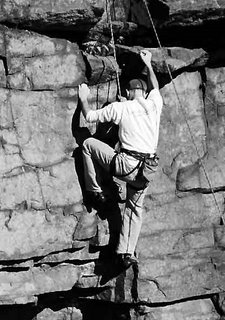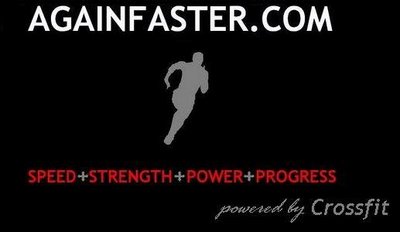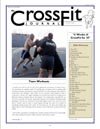Monsters of Rock
 I didn't care too much about my weight.
I didn't care too much about my weight.
Until Sunday.
That afternoon, I got an applied lesson in power-to-weight ratios. Rock climbing.
We often refer to the weight we lift in relation to our bodyweight. 1 x bodyweight bench press. 1 x bodyweight clean. 2 x bodyweight deadlift. When we do this, we're implicitly refering to a power-to-weight ratio.
You'll recall that power is a measure of work done per unit time. The equation for work is displayed below. Don't worry about the math--we're after conceptual understanding here. If you'd like to see this calculation in action, check out "A Physics Lesson", posted earlier this month.
Work = Force (Newtons) * Displacement (Meters) * Cosine of Theta (Angle between F and D)
Power is simply Work divided by Time.
When we have two athletes performing the same lift, in the same amount of time, using the same range of motion, we can say that they have done the same amount of work and exhibited the same amount of power. A problem arises when we attempt to rank these athletes. How do we determine which one is the better athlete?
We've determined that both athletes have the same power output. Neither is explicitly more powerful than the other. Still, we must take the athlete into consideration.
If our athletes have different bodyweights, one has performed the lift with greater efficiency than the other. The lighter athlete produced the same amount of power with a smaller frame. This athlete has a higher power-to-weight ratio than his/her competitor, and is therefore the stronger athlete.
In rock climbing, athletes strive to have a high power-to-weight ratio. The want to be extremely light, yet possess enough strength to haul themselves up a rock wall as fast as possible. In this scenario, the weight is no longer an external object. It is the athlete himself.

Therefore, the athlete benefits from low bodyweight. The less he/she weighs, the less work he or she has to do to get up the rock.
Let's take two hypothetical athletes, both climbing the same 50m cliff. Athlete A weighs 170 pounds (77.27 kilos), and Athlete B weighs 130 pounds (59.09 kilos).
Athlete A (work) = 77.27 kgs (9.8 m/s/s) * 50m * Cosine 0
= 757.25 N * 50m * 1
= 37852.5 N/m
Athlete B (work) = 59.09 kgs (9.8 m/s/s) * 50m * Cosine 0
= 570.08 N * 50m * 1
= 28504.00 N/m
Athlete B has to perform less work to climb the rock. Now, let's examine power output. We'll assume that each athlete climbs the rock in 15 minutes (900 seconds).
Athlete A (power) = 37852.5 N/m / 900 seconds
= 42.06 watts
Athlete B (power) = 28504.0 N/m / 900 seconds
= 31.67 watts
Athlete B has to produce less absolute power to scale the rock. However, if we examine power output per kilogram of bodyweight, the numbers tell a different story.
Athlete A (power/weight) = 42.06 watts / 77.27 kgs
= 0.54 watts/kg
Athlete B (power/weight) = 31.67 watts / 59.09 kgs
= 0.54 watts/kg
These athletes have an equivalent power-to-weight ratio, even though Athlete B is significantly smaller than Athlete A.
Light bodyweight confers an advantage: less work and less absolute power output is needed to exhibit the same power-to-weight ratio as a heavier athlete.
The advantage only holds if we assume that the two athletes climb the rock in the same amount of time. If Athlete A climbs in 12 minutes, and Athlete B climbs in 15, we get the following:
Athlete A (power/weight) = 0.68 watts/kg
Athlete B (power/weight) = 0.54 watts/kg
In the rock climbing scenario, the highest power-to-weight ratio belongs to the athlete who scales the rock the fastest, regardless of bodyweight. As in weightlifting, the power-to-weight ratio is a good way to rank different-sized athletes.
In the case of rock climbing, it is indicative of time. A higher power-to-weight ratio indicates a faster time up the wall. In weightlifting, it is indicative of moving a lot of weight with a small frame. Time is not a huge factor, because it won't vary much between athletes on any given rep.
Hopefully, this post will give you a new appreciation for smaller trainees. Next time you see someone move less weight than you, remember that their power-to-weight ratio may be significantly better than yours.
When you see a light rock climber fly up a wall in half your time, remember that they just produced a higher power-to-weight ratio than you.
Absolute strength is important, but it is not necessarily the correct way to rank athletes. Make sure you take factors such as time, bodyweight, and overall power output into consideration. One variable may not be adequate to benchmark athletic ability.
 I didn't care too much about my weight.
I didn't care too much about my weight. Until Sunday.
That afternoon, I got an applied lesson in power-to-weight ratios. Rock climbing.
We often refer to the weight we lift in relation to our bodyweight. 1 x bodyweight bench press. 1 x bodyweight clean. 2 x bodyweight deadlift. When we do this, we're implicitly refering to a power-to-weight ratio.
You'll recall that power is a measure of work done per unit time. The equation for work is displayed below. Don't worry about the math--we're after conceptual understanding here. If you'd like to see this calculation in action, check out "A Physics Lesson", posted earlier this month.
Work = Force (Newtons) * Displacement (Meters) * Cosine of Theta (Angle between F and D)
Power is simply Work divided by Time.
When we have two athletes performing the same lift, in the same amount of time, using the same range of motion, we can say that they have done the same amount of work and exhibited the same amount of power. A problem arises when we attempt to rank these athletes. How do we determine which one is the better athlete?
We've determined that both athletes have the same power output. Neither is explicitly more powerful than the other. Still, we must take the athlete into consideration.
If our athletes have different bodyweights, one has performed the lift with greater efficiency than the other. The lighter athlete produced the same amount of power with a smaller frame. This athlete has a higher power-to-weight ratio than his/her competitor, and is therefore the stronger athlete.
In rock climbing, athletes strive to have a high power-to-weight ratio. The want to be extremely light, yet possess enough strength to haul themselves up a rock wall as fast as possible. In this scenario, the weight is no longer an external object. It is the athlete himself.

Therefore, the athlete benefits from low bodyweight. The less he/she weighs, the less work he or she has to do to get up the rock.
Let's take two hypothetical athletes, both climbing the same 50m cliff. Athlete A weighs 170 pounds (77.27 kilos), and Athlete B weighs 130 pounds (59.09 kilos).
Athlete A (work) = 77.27 kgs (9.8 m/s/s) * 50m * Cosine 0
= 757.25 N * 50m * 1
= 37852.5 N/m
Athlete B (work) = 59.09 kgs (9.8 m/s/s) * 50m * Cosine 0
= 570.08 N * 50m * 1
= 28504.00 N/m
Athlete B has to perform less work to climb the rock. Now, let's examine power output. We'll assume that each athlete climbs the rock in 15 minutes (900 seconds).
Athlete A (power) = 37852.5 N/m / 900 seconds
= 42.06 watts
Athlete B (power) = 28504.0 N/m / 900 seconds
= 31.67 watts
Athlete B has to produce less absolute power to scale the rock. However, if we examine power output per kilogram of bodyweight, the numbers tell a different story.
Athlete A (power/weight) = 42.06 watts / 77.27 kgs
= 0.54 watts/kg
Athlete B (power/weight) = 31.67 watts / 59.09 kgs
= 0.54 watts/kg
These athletes have an equivalent power-to-weight ratio, even though Athlete B is significantly smaller than Athlete A.
Light bodyweight confers an advantage: less work and less absolute power output is needed to exhibit the same power-to-weight ratio as a heavier athlete.
The advantage only holds if we assume that the two athletes climb the rock in the same amount of time. If Athlete A climbs in 12 minutes, and Athlete B climbs in 15, we get the following:
Athlete A (power/weight) = 0.68 watts/kg
Athlete B (power/weight) = 0.54 watts/kg
In the rock climbing scenario, the highest power-to-weight ratio belongs to the athlete who scales the rock the fastest, regardless of bodyweight. As in weightlifting, the power-to-weight ratio is a good way to rank different-sized athletes.
In the case of rock climbing, it is indicative of time. A higher power-to-weight ratio indicates a faster time up the wall. In weightlifting, it is indicative of moving a lot of weight with a small frame. Time is not a huge factor, because it won't vary much between athletes on any given rep.
Hopefully, this post will give you a new appreciation for smaller trainees. Next time you see someone move less weight than you, remember that their power-to-weight ratio may be significantly better than yours.
When you see a light rock climber fly up a wall in half your time, remember that they just produced a higher power-to-weight ratio than you.
Absolute strength is important, but it is not necessarily the correct way to rank athletes. Make sure you take factors such as time, bodyweight, and overall power output into consideration. One variable may not be adequate to benchmark athletic ability.




















2 Comments:
Ok you are small and you are strong, is that what you want to hear?!? Jesus, who gave Napoleon here a calculator!! JK
I hear you on the relative strength thing, just beware it has its limitations.
Lifter “A” weighs 300 lbs and Lifter “B” weighs 150 lbs. “A” Squats 900lbs while “B” lifts 475lbs. In relative strength focus “B” is lifting 3.16666 times BW while “B” is only lifting 3 times BW. However, “B” is still lifting 900lbs!!! All the ratios in the world can’t change the fact that the number of 900 squatters is far smaller than the number of 475 squatters. It all depends on your goals.
By the way, the first comment was in no way intended to belittle Jon. He is much stronger and faster than the majority of the people looking at this blog, to include his stalking of my dead lift max. This argument however has become the battle cry for smaller people that feel they need to justify their worth in the gym.
Smaller guys of the world hear these words. Who cares if you are smaller, your clothes probably look better on you and society likes that look better than the big guys anyway.
Cheers,
-Will
Napoleon was a badass. He just happened to be a short badass. He was a master tactician, and a brilliant politician. Despite his renown for ruthlessness, I bet he couldn't deadlift sh*t. Pussy.
Any argument is refutable when it is taken to extremes. Ants can lift 10 times their bodyweight over their head, but no one would make the argument that ants are stronger than humans, who max out around 2-2.5x bodyweight overhead. Relative strength has shortfalls, as Will points out.
I have no doubt that the guy who squats 900 pounds is more impressive than the guy who squats 475, regardless of bodyweight.
Based on math alone, we can see that work, power, and power-to-weight ratios are based on bodyweight and speed. Big guys have a harder time producting big power-to-weight ratios because they're so big. Little guys have it easy--a bodyweight benchpress for me is only 170 lbs., but it's closer to 200 for Will.
Benchmarking your lifts based on bodyweight may be a bit of a cop-out, but it's a convenient rule of thumb, and a great way to scale workouts for all of your athletes.
All in all, screw bodyweight comparisons. I don't go into my lifts looking to move less weight than the next guy, simply because he's bigger than me. If I can hack it, I'm going to lift more, and then quietly bask in the attendant glory.
On the flip side, the big guy shouldn't go into his lifts thinking that he shouldn't strive for a 1.5x, 2x, or 2.5x lift just because it's harder for him than for the little guy.
The bodyweight comparison has worked its way into our minds because we see it everywhere in the fitness literature. Like anything else, take the time to think about what it really means, and don't use it as a crutch if you're not making progress.
Go faster!
Post a Comment
<< Home